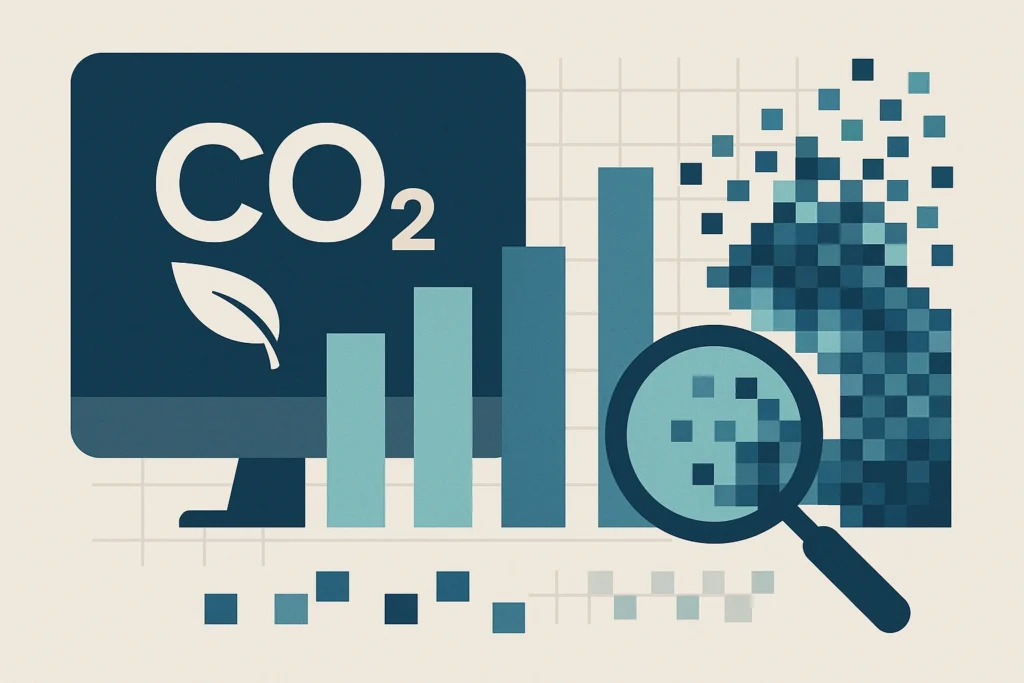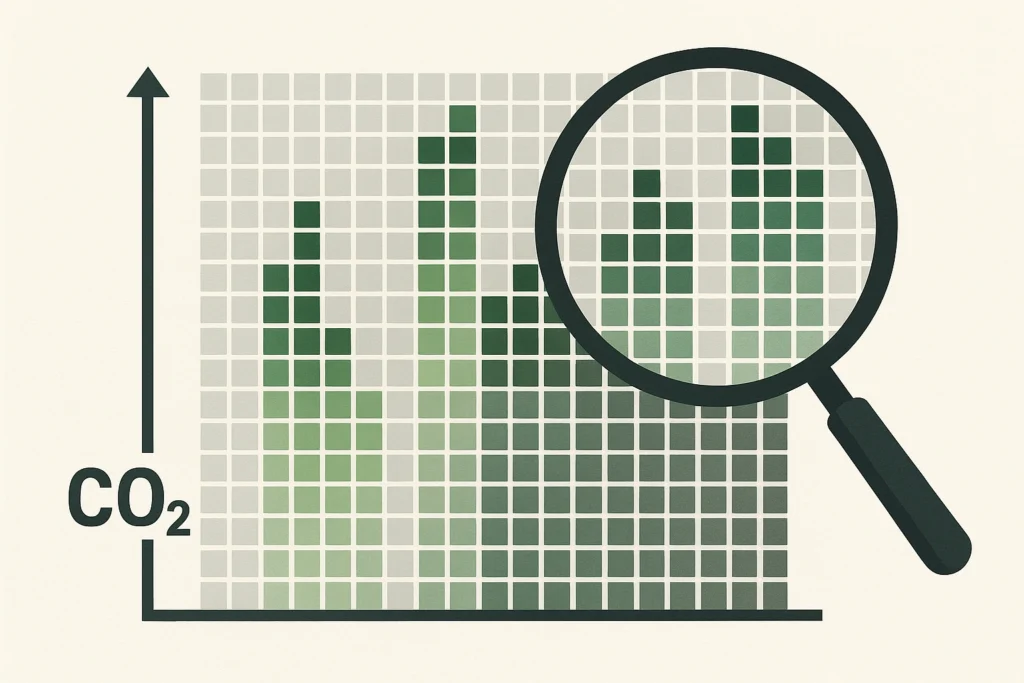Why Data Granularity Is Crucial in Scientific Carbon Reporting
As the world ramps up its efforts to fight climate change, companies are under intense pressure to get a handle on their greenhouse gas (GHG) emissions. And while most businesses get why they need to report this information, a lot of them are still getting bogged down in the technical side of things. One of the biggest mistakes? Relying on averaged, big-picture data. This approach can lead to climate claims that aren’t just inaccurate but practically useless. The secret to credible and effective carbon management is all about carbon data granularity.
Put simply, this means gathering emissions data in the most detailed way possible. The more specific your data, from the first step in your supply chain to a product’s final journey, the more accurate and useful your insights will be.
We’ll show you why it’s a must-have for building a climate strategy you can trust, enabling accurate reporting, and staying compliant.
What Is Data Granularity in Carbon Reporting?
Data granularity in carbon reporting refers to the level of detail in carbon emissions data, ranging from high-level, broad estimates to fine-grained, specific measurements.
High granularity provides more precise insights into emissions sources by enabling data to be broken down into smaller units like products, processes, or even real-time facility data. This level of detail allows organizations to identify hotspots, uncover inefficiencies, and report emissions with scientific credibility.
The Physics of Granularity: Tracing the Molecule
At a fundamental level, carbon lifecycle reporting is about tracking the flow of carbon molecules. Granular data allows you to trace this flow from its source through the entire value chain. This precision is essential for a true carbon audit, as it provides a clear, verifiable record of where emissions are generated and where they can be cut.
Scope 1 and 2 Emissions
Even for direct emissions, granularity matters. Instead of just reporting total electricity consumption for an entire factory, precision carbon tracking should break it down by machine, shift, or process. This reveals which pieces of equipment are energy hogs and where maintenance or a technology upgrade would have the biggest impact.
Scope 3 Accuracy
This is where carbon data granularity truly shines. Scope 3 emissions, which represent the vast majority of a company’s footprint, are notoriously difficult to track. Using financial data and industry averages for purchased goods provides a rough estimate but offers no actionable insight. Granular data, on the other hand, captures the specific emissions tied to each supplier, product component, and shipping route. This is the difference between knowing that “purchased goods account for 50% of our emissions” and knowing that “the plastic we buy from Supplier X for Product Y has a carbon intensity that is 30% higher than the industry average.”
A granular approach moves beyond a simple, static report. It creates a dynamic system for real-time management and optimization.
Also See: The Physics of Carbon Capture: What ESG Tools Must Track
Why Granularity Matters: From Estimates to Evidence

Accuracy in Scope 3 Emissions
Scope 3 emissions which are indirect emissions across the supply chain make up to 70–90% of a company’s footprint. Without granular data, these figures often rely on industry averages or vague multipliers. That leads to underreporting or overreporting.
Granular tracking allows businesses to analyze emissions at the supplier, shipment, or even product level. As a result, this precision helps companies build trust with regulators and investors, where scope 3 accuracy is critical.
Better Climate Compliance
Governments and ESG regulators increasingly demand detailed ESG reporting. Frameworks like the CSRD (EU) or SEC climate disclosures emphasize transparency in assumptions and methods.
Companies using carbon audit software with high granularity can demonstrate compliance. It shows not just totals, but the journey of how each figure was calculated.
From Generic Insights to Actionable Strategy
Broad averages may identify that “transportation is a hotspot,” but granular data pinpoints which routes, suppliers, or materials drive the problem. As a result, this allows companies to take targeted action, like switching a single logistics partner or material supplier, leading to measurable reductions.
Scientific Carbon Tools and Granularity
The push for scientific carbon tools comes from the demand for accuracy. These tools provide organizations with methods to capture emissions data at scale while maintaining detail.
Features of scientific tools include:
- Real-time data collection: Integrating IoT sensors in supply chains to capture energy use.
- Lifecycle analysis modules: Mapping carbon impact across raw material extraction, manufacturing, transport, use, and disposal.
- Granular reporting layers: Enabling users to drill down from enterprise-wide totals to facility, process, or product-level emissions.
By using these systems, companies achieve emissions data precision that can withstand audits and satisfy compliance bodies.
Examples of Carbon Data Granularity in Practice
1. Manufacturing Sector
Instead of reporting “factory emissions” as one number, a granular approach tracks:
- Individual machines’ energy consumption.
- Materials sourced for each production batch.
- Waste streams by product line.
This highlights inefficiencies, like a single outdated machine contributing disproportionately to emissions.
2. Logistics and Transportation
Granularity means moving beyond average fleet emissions. Companies track:
- Vehicle type and age.
- Load efficiency per trip.
- Fuel mix (diesel vs. electric).
Such data reveals where electrification or route optimization brings the biggest gains.
3. Retail and Consumer Goods
For large retailers, granularity maps emissions across:
- Supplier tiers (Tier 1 vs. Tier 3).
- Packaging materials by product line.
- Customer use-phase impact (e.g., energy needed for appliances).
The result is more transparent reporting and stronger carbon lifecycle visibility.
Benefits of High-Granularity Carbon Data
Credibility and Trust
Investors want proof, not estimates. Granular data gives confidence in GHG reporting accuracy.
Operational Efficiency
Detailed analysis uncovers cost-saving opportunities, from energy waste to inefficient suppliers.
Competitive Advantage
Companies that demonstrate precision carbon tracking win favor with climate-conscious investors and customers.
Future-Proof Compliance
Regulations will only get stricter. Granularity today prepares businesses for tomorrow’s reporting standards.
Challenges of Carbon Data Granularity

While valuable, achieving high granularity isn’t easy. Some challenges include:
Data Overload: Collecting and storing massive volumes of detailed data requires scalable systems.
Supplier Collaboration: Getting suppliers to share accurate, detailed data is often difficult.
Integration Gaps: Many organizations lack seamless links between ERP, logistics, and climate software tech.
Cost and Complexity: Deploying carbon audit software and training staff takes investment.
Still, the benefits outweigh the challenges, especially as automation and scientific emissions data tools improve.
Also See: Blockchain Carbon Accounting and Transparent Emission Tracking
How Carbon Audit Software Enables Granularity
Modern carbon audit software is built to handle these challenges. Features that support data granularity include:
- Automated data ingestion: Pulling information directly from utility bills, IoT sensors, and supplier platforms.
- Standardized frameworks: Aligning reports with GHG Protocol, ISO standards, and regulatory formats.
- Drill-down dashboards: Letting users toggle from global emissions to department or process level.
- Scenario modeling: Using granular data to simulate how changes (e.g., supplier shift) impact carbon totals.
By blending automation with precision, these systems turn granular data into actionable insights.
The Future: Precision and Predictive Reporting
Granularity doesn’t just improve current reports. It lays the groundwork for predictive models like:
- AI-driven forecasting: Predict how emissions will change if production scales up.
- Carbon intensity tools: Measure emissions per product unit or per dollar revenue, using granular inputs.
- Cross-sector benchmarks: Compare one company’s detailed emissions profile against industry peers.
The end goal is not just compliance, but smarter business planning rooted in scientific emissions data.
FAQ: Carbon Data Granularity
What does carbon data granularity mean in simple terms?
It means collecting emissions data at a very detailed level, not just big totals.
Why is granularity important in scope 3 emissions?
Scope 3 makes up most emissions and is hard to measure. Granular data ensures accuracy and avoids misleading estimates.
How do scientific carbon tools improve granularity?
They integrate detailed tracking, lifecycle analysis, and drill-down reporting features.
Is collecting granular data too costly?
It requires investment, but savings in efficiency, compliance, and trust often outweigh the costs.
How does carbon audit software support climate compliance?
It provides transparent, verifiable, and standardized emissions data that meets regulatory requirements.
Conclusion
Transitioning to a low-carbon economy means companies must change how they think about their data. It’s time to move past rough guesses and embrace the power of precise, granular data. This isn’t about being precise for the sake of it, it’s about using precision to find the real sources of emissions, measure how well reduction efforts are working, and create a believable, science-backed climate strategy.
For any company that’s serious about its environmental impact, investing in scientific carbon tools and tracking emissions with precision isn’t a choice anymore. It’s the only way to move from just reporting emissions to actually and effectively reducing them.









